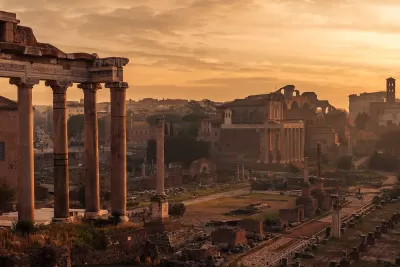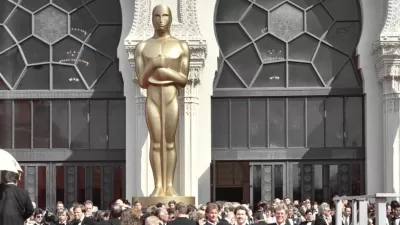The sprawling film offers a bleak vision of city-building that minimizes the impacts of top-down development on everyday citizens.

This is a guest blog by Noah Harper.
As a city planner, what I wished for in the recent film Megalopolis and what the film delivered were two very different things.
I’d imagined an ideological clash between an architect and a mayor, a dramatized debate on the merits of clinging to the past versus sweeping change to meet the very real needs of the present, all told in the sprawling, operatic style that Francis Ford Coppola brought forth in his earlier work in The Godfather.
Instead, the film is a muddled, grandiose mess — with only a handful of interesting ideas hidden in its two-hour-plus runtime.
In my work as a community planner in the Boston area, I live with that change-versus-preservation tension between the very real, urgent needs of a housing crisis that is slowly pushing all but the most deep-pocketed out into the suburbs and across state lines, and a strong desire to keep the built environment exactly as it is today. It’s a question that I mull in my head as I walk the historic red brick sidewalks in my neighborhood: should be saved or remade anew?
In the film, a fictionalized version of New York City faces similar challenges, and Coppola’s architect, played by Adam Driver, has grand plans for an entirely new neighborhood that will solve them. I particularly appreciated how Driver’s architect emphasized that the foundation of such a place should be democratic discourse, that utopia is made from people asking the question of what it might look like. Unfortunately, while the character speaks in favor of robust community engagement and participation, he fails to put it into practice.
Neither the architect nor the film seem to really believe that a great city and neighborhood are made by many hands, shaped by thousands of different people in thousands of different ways. Instead, in practice, it is the same old architect (or planner) in the proverbial ivory tower looking down at the rabble on the streets below, making a plan for them rather than with them.
Unfortunately, the everyday citizens of this odd, faux-Roman metropolis are summarily ignored, portrayed only as a raucous crowd cheering at a gladiatorial bacchanal or an angry mob rioting in the streets and setting fire to their own city. Even in the film’s finale, after Driver’s grand vision is finally realized, they are just hazy silhouettes standing around the architect’s poorly rendered fantasyland with little to do and with precious little evidence that they had any real say in what this place looked like.
To this planner’s mind, this is a severe misstep. The idea that we can solve our problems together through discussion and building consensus for solutions is what the planning profession is all about. Long gone, I hope, are the days of a solitary man in a room, dreaming and demanding what an entire city should be.
But, like the architect’s lofty ideals and poor execution in the film, the planning field often bungles engagement and implementation. We fail to reach the people for whom the plan really matters and, when push comes to shove, we leave them out of making the plan’s vision a reality.
Like the titular Megalopolis, the modern “utopia” is then made by — and for — the few, rather than the many. It fails to solve the problem by failing to involve the people whose lives our plans impact most.
Noah Harper is a city planner and film enthusiast based in Boston. You can find more of his writing at powerandplace.substack.com.

Alabama: Trump Terminates Settlements for Black Communities Harmed By Raw Sewage
Trump deemed the landmark civil rights agreement “illegal DEI and environmental justice policy.”

Planetizen Federal Action Tracker
A weekly monitor of how Trump’s orders and actions are impacting planners and planning in America.

The 120 Year Old Tiny Home Villages That Sheltered San Francisco’s Earthquake Refugees
More than a century ago, San Francisco mobilized to house thousands of residents displaced by the 1906 earthquake. Could their strategy offer a model for the present?

Ken Jennings Launches Transit Web Series
The Jeopardy champ wants you to ride public transit.

BLM To Rescind Public Lands Rule
The change will downgrade conservation, once again putting federal land at risk for mining and other extractive uses.

Indy Neighborhood Group Builds Temporary Multi-Use Path
Community members, aided in part by funding from the city, repurposed a vehicle lane to create a protected bike and pedestrian path for the summer season.
Urban Design for Planners 1: Software Tools
This six-course series explores essential urban design concepts using open source software and equips planners with the tools they need to participate fully in the urban design process.
Planning for Universal Design
Learn the tools for implementing Universal Design in planning regulations.
Clanton & Associates, Inc.
Jessamine County Fiscal Court
Institute for Housing and Urban Development Studies (IHS)
City of Grandview
Harvard GSD Executive Education
Toledo-Lucas County Plan Commissions
Salt Lake City
NYU Wagner Graduate School of Public Service




























